Community Customs Associated with Political Subordination
скачать скачать Автор: Barry III, Herbert - подписаться на статьи автора
Журнал: Social Evolution & History. Volume 2, Number 1 / March 2003 - подписаться на статьи журнала
Abstract
Political subordination of a community may be expected to influence behavior of the individuals. Differences in numbers of government levels above the community, from none to more than two, were compared in a world sample of 88 communities. The ethnographic information was obtained when the communities had slight or no acculturation due to contact with European intruders. Customs selectively associated with increasing government levels are payment for marriage, frequent external warfare, non-maternal caretakers of young children, schooling through late childhood, requirement of obedience by adolescents, prohibition of premarital sexual intercourse by girls, multiple residences of families, presence of large buildings, low indulgence of young children, and frequent punishment of older children. The adverse effects of government on the members of the community might be counteracted by minimizing social stratification and by maximizing autonomy of the community.
Introduction
Various customs have been measured on a standard world sample of 186 societies specified by Murdock and White (1969). Criteria for selection of each society were adequate ethnographic information and geographical and linguistic separation from all the other societies. A single community was selected to represent each society. A book edited by Barry and Schlegel (1980) reproduces the article by Murdock and White and subsequent articles in the Journal Ethnology containing the information on the 186 communities.
A purpose of the sample was to include each known major cultural type. The societies range from independent communities to components of large nations. Examples of government levels above the community are a county or district, a state or province, and a nation. An increase in number of government levels constitutes an increase in cultural complexity. In addition to the intrinsic complexity, multiple government levels are usually accompanied by higher degrees of technological and social complexity.
The effects of political subordination are difficult to separate from cultural attributes that generally accompany multiple levels of political hierarchy. Large nations generally also have highly developed social stratification, technological specialization, a dense rather than sparse population, and food obtained by cultivating crops rather than by collecting or hunting wild fruits, vegetables, animals, and fish.
The present study identifies several community customs that are selectively associated with subordination to government above the local community. Successively different levels of the customs are associated with a progressive increase in the number of government levels above the community. The findings indicate adverse effects of government above the local community. The findings also suggest interventions that can counteract the adverse effects.
Inference that political subordination is the cause of a custom requires evidence that the custom is selectively associated with political subordination rather than with other types of cultural complexity. Partial correlations of customs with government levels above the community identify customs that continue to be associated with political subordination when controlling for other measures of cultural complexity.
Methods
Murdock and Provost (1973) specified five ordinal levels of political integration. The two lowest levels are components of the local community and autonomous communities. They are combined into a category of independent communities. The new measure therefore has four ordinal levels ranging from zero to three. Successive degrees of subordination are one administrative level, such as a petty state, two levels, such as a small state divided into administrative districts, and three or more levels, such as a large state organized into provinces, which are subdivided into districts. Each community therefore is classified as being politically independent or subordinate to one, two, or more than two government levels.
Political complexity was coded on the 186 communities of the standard world sample described by Murdock and White (1969). The analyses were applied to 88 communities that were described at a time of slight or no acculturation due to contact with European invaders or visitors. Acculturation was coded by the author and Brian L. Yoder, using an unpublished summary description of each community. Most of the descriptions were by George P. Murdock or Douglas R. White.
The remaining 98 communities in the standard world sample are excluded because their aboriginal political organization had been severely disrupted at the time of the ethnographic description. The following examples of the most severe category of acculturation include the name of the society and its location in one of six world regions identified in Table 1. Independent communities are the Montagnais and Huichol of North America. Communities with one level of higher government are the Popoluca of North America and the Quiche, Miskito, Aymara, and Mapuche of South America. Communities with two levels of higher government are the Basques of the Circum-Mediterranean and the Tobelorese of the Insular Pacific. Communities with more than two levels of higher government are the Armenians of the Circum-Mediterranean and the Haitians of South America.
Murdock and Provost (1973) specified five ordinal levels for nine measures of cultural complexity in addition to government levels. Four measures, most closely associated with government levels above the community, are social stratification, technological specialization, population density, and agriculture.
Five levels of social stratification are (1) egalitarian, (2) hereditary slavery or wealth distinctions, (3) two social classes of freemen, (4) social classes plus hereditary slavery or caste divisions, (5) three or more classes or castes. Five levels of technological specialization are (1) absence of metal working, loom weaving, and pottery making, (2) presence of pottery, (3) presence of loom weaving, (4) presence of metal workers but absence of loom weaving or of pottery, (5) presence of all three types of craft specialists. Five levels of population density per square mile are (1) fewer than one person, (2) 1–5, (3) 5.1–25, (4) 26–100, (5) more than 100. Five levels of agriculture are (1) none or nonfood crops, (2) less than 10% of the food, (3) less than some other subsistence activity, (4) more than any other activity but without intensive techniques, (5) more than any other activity by an intensive technique of irrigation, plowing, or artificial fertilization.
Five of the measures of cultural complexity are omitted from the data analyses because they are less closely associated with government levels above the community. These five measures are (1) writing and records, (2) fixity of residence, (3) urbanization measured by the average population of local communities, (4) land transport, (5) use of money.
Statistical analyses used the techniques of simple correlation and partial correlation. The calculations were by Version 6.1 of the SPSS statistical package (SPSS, 1994). Statistical significance of the difference of simple correlations from zero uses the two-tail criterion, measuring the probability that the difference can be as large or larger by random chance in either the positive or negative direction. Statistical significance of the difference of partial correlations from zero uses the one-tail criterion because the simple correlation determines the positive or negative direction.
Results
One of the cultural customs, payment for marriage, was obtained from codes reported by Schlegel and Eloul (1987, 1988).
TABLE 1
Custom at marriage is no gifts, service or exchange, bride-price, or dowry. Government levels above the community are coded as NONE, ONE, TWO, or MORE. The geographical area following the name of the community is Af (Africa), CM (Circum-Medi-terranean), EE (East Eurasia), IP (Insular Pacific), NA (North America), or SA (South America).
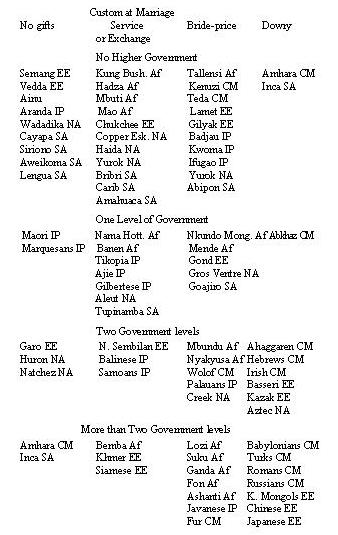
Table 1 identifies for each of the 88 communities one of four customs of payment at marriage: (1) no gifts, (2) bride-service or woman exchange, (3) bride-price, paid by the groom or his family to the bride's family, (4) dowry. Two types of dowry are direct and indirect. Dowry is direct if the bride or her family pays the groom. Dowry is indirect if the groom or his family pays the bride. The communities with each custom of payment are grouped in Table 1 according to government levels above the community: none, one, two, or more than two. The name of each society is followed by its location in one of six geographical areas.
Payment for marriage is associated with government levels. The majority of communities with no gifts have no government above the community. A slight majority of communities with bride-service or woman exchange have one or more government levels above the community. A greater majority of communities with bride-price have one or more government levels above the community. Most communities with dowry have two or more government levels.
In Table 2, the number of communities, the average score for government levels, and the standard deviation of the average score for government levels are shown for each level of payment for marriage and for five other customs. Differences in the six customs are strongly associated with differences in government levels.
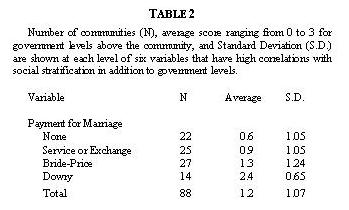
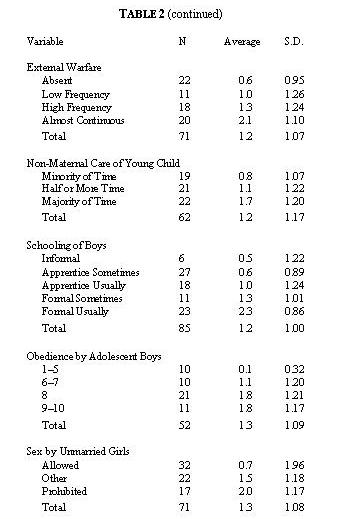
External warfare was coded by Ember and Ember (1992). Their ordinal scale is reduced to four categories: (1) Absent, (2) Low Frequency, (3) High Frequency, (4) Almost Continuous. Increase in government levels above the community is also associated with more frequent internal warfare, but this relationship is less consistent.
Non-maternal care for young children is from a code on infancy and early childhood (Barry and Paxson 1971). Five categories are (1) Almost exclusively the mother, (2) Principally the mother, but others have important roles, (3) Child spends half or less of the time with mother, (4) Majority of time is spent away from mother, (5) Practically all the time is spent away from the mother. Categories 1 and 5 occurred in none of the 88 communities.
Two codes, Schooling of Boys and Obedience by Adolescent Boys, were coded for both boys and girls. The codings and their relationships with government levels are closely similar for both sexes. The codes for boys are used because the information permitted coding slightly more boys than girls.
Schooling of Boys was coded by Barry, Josephson, Lauer, and Marshall (1977). It pertains to the later stage of pre-adolescent childhood. The categories are (1) Informal training only, with minimal guidance, (2) Apprenticeship (guidance) is atypical or occasional, (3) Apprenticeship is typical and frequent but informal training is more prevalent, (4) Apprenticeship is predominant, (5) Formal schooling is atypical or occasional, (6) Formal schooling is typical and frequent.
Obedience by adolescent boys is a rating of the degree to which obedience to parents and other adults is required. It is one of the measures reported by Schlegel and Barry (1991). The original scale scores, which varied from 2 to 9, were grouped into four categories.
Prohibition of sexual intercourse by unmarried girls was coded by Murdock (1967). Six codes were grouped into three ordinal categories. (1) Allowed: combines codes for allowed, trial marriage, and freely permitted. (2) Other: combines codes for early marriage and weakly censured. (3) Forbidden.
The six community customs in Table 2 generally indicate decrease in freedom of the individual or imposition of other adverse conditions associated with increasing government levels above the community. Payment in marriage, schooling, requirement for obedience, and prohibition of sexual intercourse by unmarried girls are restrictions on freedom of choice. External warfare and less time for the young child with the mother are generally adverse conditions. The average number of government levels increases with each successive level of each custom. This is a monotonic ordinal relationship.
In Table 3, the measures of government levels shown in Table 2 are applied to four customs that continue to be highly associated with government levels when the partial correlation controls for the effect of social stratification. These customs therefore are not highly associated with social stratification.
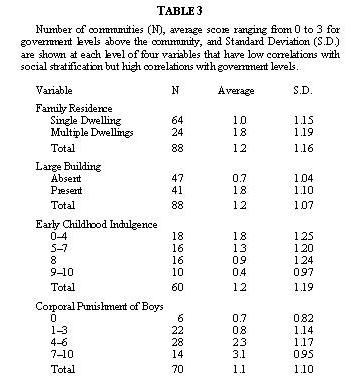
Residence of the family in multiple dwellings instead of a single dwelling and presence of a large building, are adapted from codes by Murdock and Wilson (1972). Single Dwelling combines four codes: (1) Longhouse, which includes other families, (2) Apartment, (3) Family, (4) Homestead. Multiple dwellings include four other codes: (1) Multi-Dwelling Family, (2) Multi-Dwelling Wife with Children, (3) Mother-Child, (4) Multi-Family Individual Spouse. Absence of a large building is the code ‘None’ for a measure of Large Structures. The types of large structures are (1) Residence, (2) Public, (3) Ceremonial, (4) Military, (5) Economic.
Low degree of indulgence in the treatment of young children is from ratings of infancy and early childhood (Barry and Paxson 1971). It is a general measure that takes into account frequency and intensity of nurturance and of punishment between the ages of two and five years. Scale scores from 0 to 10 were combined to obtain four ordinal categories. Frequency of corporal punishment of older boys prior to adolescence is from a code by Barry, Josephson, Lauer, and Marshall (1977). Scale scores from 0 to 10 were combined to obtain four categories. The results are closely similar for corporal punishment of girls. The scores for boys have the advantage of being available on a slightly larger number of communities.
Separate dwellings for family members and presence of large buildings suggest that government levels are associated with social hierarchy although these customs are not highly associated with the measure of social stratification. Low degree of early childhood indulgence and frequent corporal punishment imply that government levels are associated with harsh treatment of children. Average score for government levels above the community has an ordinal relationship with each of the ten variables in Tables 2 and 3.
The associations of customs with government levels do not demonstrate that the associations are specifically with government levels rather than being more highly associated with other measures of cultural complexity. The specificity of the associations with government levels was tested by partial correlations, controlling for four measures of cultural complexity that are the most highly associated with government levels.
The ten customs identified in Tables 2 and 3 are listed in Table 4.
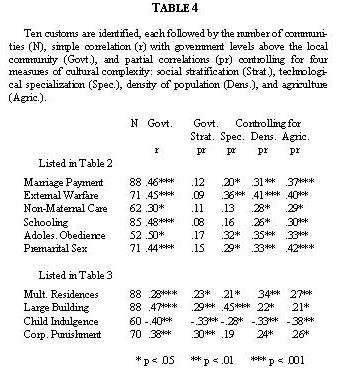
The correlation of each custom with government levels is followed by the partial correlations when controlling for the designated one of four measures of cultural complexity. Social stratification has a special relationship with government levels. The correlation of government levels with social stratification is .76, higher than with any of the other eight measures of cultural complexity. For the six customs identified in Table 2, the partial correlations that control for social stratification are low and not statistically significant.
Contrary to the partial correlations that control for social stratification, the partial corelations that control for technological specialization, population density, and agriculture are generally high and statistically significant. The only exceptions are for two customs, non-maternal care and schooling, with technological specialization.
For the four customs identified in Table 3, the partial correlations are predominantly high and statistically significant when controlling for any of the four measures of cultural complexity. The only partial correlation that is not statistically significant is for corporal punishment with technological specialization.
Discussion
A limitation of the standard world sample is that the coded information on each community is based on observations in a single, specified year. Customs are not compared before and after a change in government levels, such as an independent community that becomes subordinate to a higher government or a subordinate community that gains independence.
An advantage of the standard world sample is that it contains a substantial number of communities with each of the four government levels above each individual community, from none to more than two. Ordinal differences in ten customs are associated with ordinal differences in the number of government levels. Selection of communities with little or no acculturation by European intruders maximizes the stability of the political structure for the 88 communities that were selected for the present analysis. The number of government levels has usually remained the same for multiple previous generations of individuals. The customs of the communities therefore may be interpreted as adaptations to the number of government levels above the community.
Multiple government levels above the community are necessary for the survival and prosperity of some communities. Integration of large populations over a large area expands resources and provides defense against aggressors. A large nation is able to develop complex technology. Contemporary world civilization is dominated by the modern industrialized nations.
Table 2 lists six customs that are associated with government levels above the community and also with social stratification. Each custom has specific detrimental effects.
Two of the six customs pertain to adulthood. Payment of a dowry or bride-price allows the marriage to be determined by older family members instead of by the couple. Frequent warfare is a consequence of the large territory controlled by a single nation or empire, which fights either aggressive or defensive wars against competing nations or empires. The destructive external warfare is controlled by the highest level of government rather than by the community. The correlation between government levels and frequency of internal warfare is positive, indicating that government usually fails to fulfill its purpose of enforcing internal tranquility and security.
Four of the six customs pertain to treatment of children. Non-maternal care for young children and schooling take children away from the mother, who has a uniquely strong desire to protect her children. Requirement for high degree of obedience by adolescent boys and prohibition of sexual intercourse by adolescent girls constitute control of the children by adults. Control of the children by parents and other adults imitates the control of the community by higher government levels.
Table 3 lists four customs associated with government levels above the community but not with social stratification. These four customs have other types of detrimental effects. Separate dwellings impair the unity of the family. Large buildings are usually imposed on the community by a higher level of government. Harsh treatment of children, indicated by less early childhood indulgence and more frequent corporal punishment, might express resentment of parents and other adults against domination of the community by higher government levels.
Government above the community usually constitutes authoritarian rule of the community by an external higher government. The authoritarian rule of the community is usually imitated by authoritarian selection of community leaders. Democratic selection of community leaders therefore may be a beneficial custom that counteracts the adverse effects of political subordination of the community. In a large world sample of communities, democratic selection of community leaders is associated with a small instead of extended size of the families (Bondarenko and Korotayev 2000) and with monogamous instead of polygynous marriage (Korotayev and Bondarenko 2000). These findings give evidence that small, monogamous families are beneficial influences in politically subordinated communities.
In accordance with attributes of small, monogamous families, Table 3 shows that political subordination of the community is associated with residence of the family in multiple dwellings. Residence in a single dwelling usually characterizes small, monogamous families. Residence in a single dwelling by large, polygynous families might be a beneficial influence in politically subordinated communities.
A decrease in social stratification might counteract the detrimental effects of six customs associated with political subordination of the community and also with social stratification, listed in Table 2. In spite of the high correlation between government levels and social stratification, it is feasible to change social stratification without changing government levels. Slavery was almost universally condemned and abolished in the nineteenth and twentieth centuries. Castes, which restrict scope of marital partners, are also ‘politically incorrect’. Distinctions on the basis of social class and wealth can be minimized to approach to the generally accepted ideal of equal opportunity for all human beings. Early in the twentieth century, the effort by the Soviet Union to abolish class and wealth distinctions was partly successful. In comparison with the nineteenth century, Russia now benefits from a closer approach to equal opportunity for all citizens.
An alternative remedy for the adverse effects of political subordination is to increase autonomy of the communities. For example, in the United States of America the schools are traditionally financed and controlled by the local school district rather than by a higher government. The communities can do many other government functions. Public recognition of the advantages of local autonomy may lead to broader scope of independence for the communities, even in the largest nations.
Acknowledgments
Statistical analyses were performed at the Computing Services and Systems Development, University of Pittsburgh.
References
Barry, H., III, and Paxson, L. M.
1971. Infancy and early childhood: cross-cultural codes 2. Ethnology 10: 466–508.
Barry, H., III, Josephson, L., Lauer, E., and Marshall, C.
1977. Agents and techniques for child training cross-cultural codes 6. Ethnology 16: 191–230.
Barry, H., III, and Schlegel, A. (ed.)
1980. Cross-cultural sample and codes. Pittsburgh, PA: University of Pittsburgh Press.
Bondarenko, D., and Korotayev, A.
2000. Family size and community organization: a cross-cultural comparison. Cross-Cultural Research 34: 152–189.
Ember, M., and Ember, C. R.
1992. Warfare, aggression, and resource problems: cross-cultural codes. Behavior Science Research 26: 169–226.
Korotayev, A., and Bondarenko, D.
2000. Polygyny and democracy: a cross-cultural comparison. Cross-Cultural Research 34: 190–208.
Murdock, G. P.
1967. Ethnographic Atlas. Pittsburgh, PA: University of Pittsburgh Press.
Murdock, G. P., and Morrow, D. O.
1970. Subsistence economy and supportive practices: Cross-cultural codes 1. Ethnology 9: 302–330.
Murdock, G. P., and Provost, C.
1973. Measurement of cultural complexity. Ethnology 12: 379–392.
Murdock, G. P., and White, D. R.
1969. Standard cross-cultural sample. Ethnology 8: 329–369.
Murdock, G. P., and Wilson, S. F.
1972. Settlement patterns and community organization: cross-cultural codes 3. Ethnology 9: 254–295.
Schlegel, A., and Eloul, R.
1987. A new coding of marriage transactions. Behavior Science Research 21: 118–140.
Schlegel, A., and Eloul, R.
1988. Errata. Behavior Science Research 22: III.
Schlegel, A. and Barry, H., III
1991. Adolescence: an Anthropoligical Inquiry. New York: The Free Press.
SPSS Inc.
1994. SPSS 6.1 Syntax Reference Guide. Chicago: SPSS.





